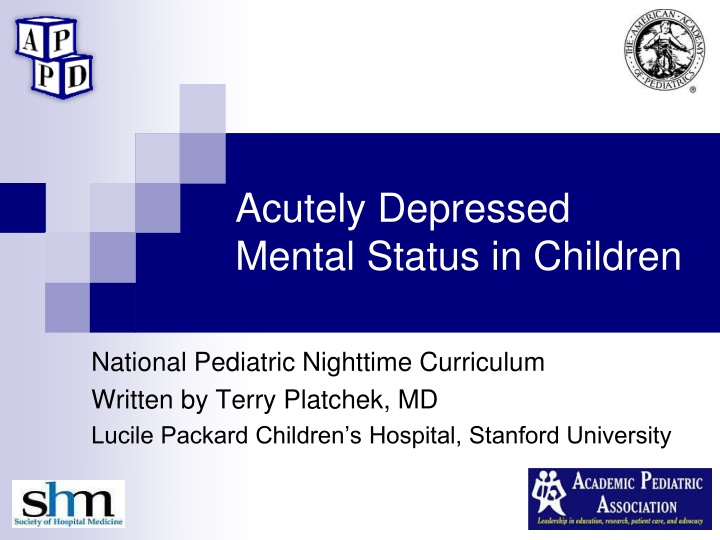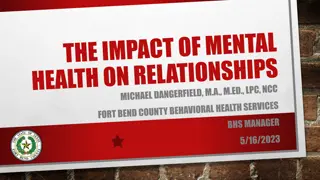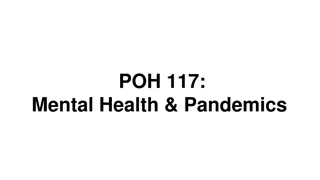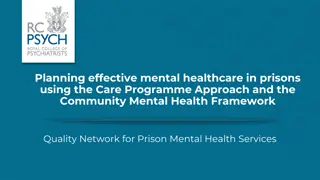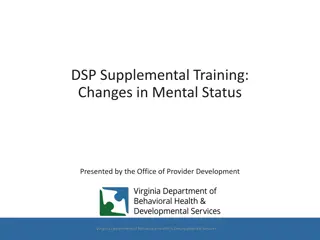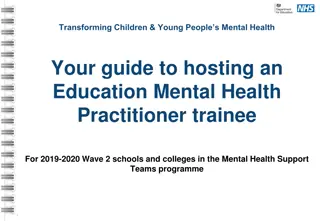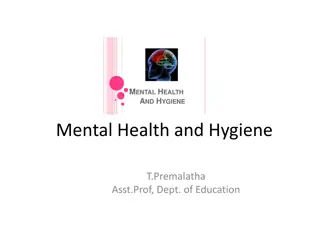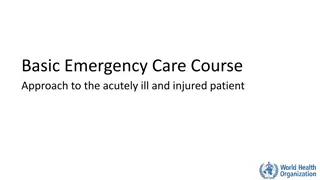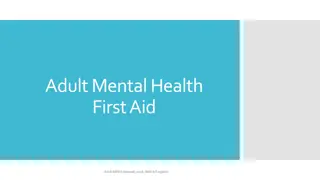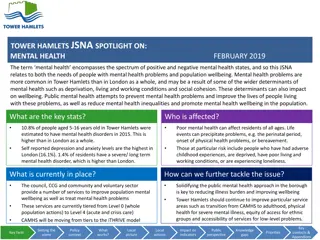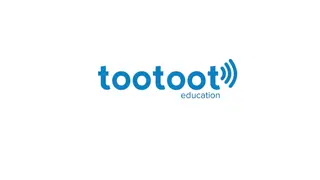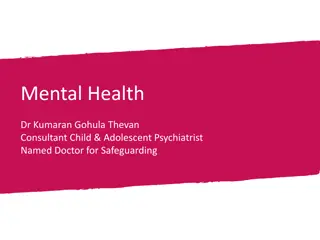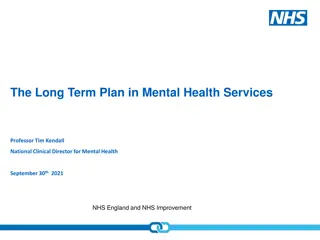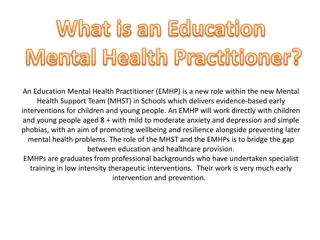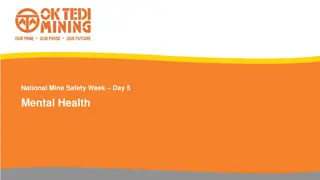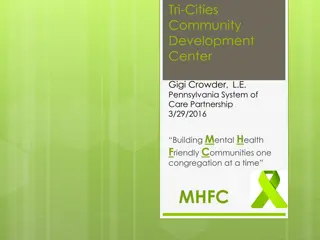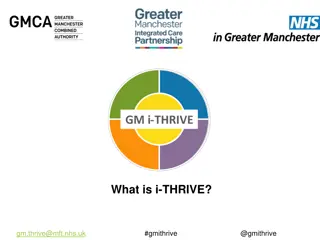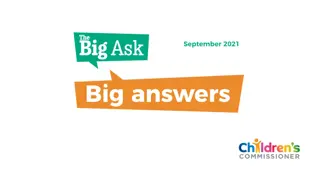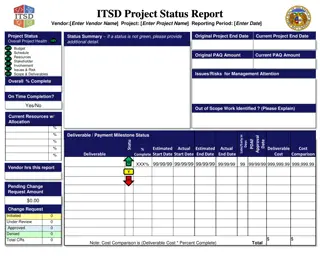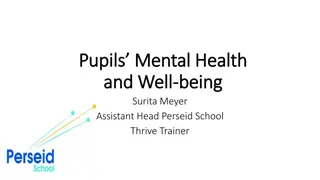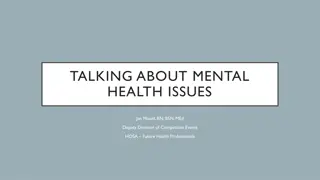Acutely Depressed Mental Status in Children
Exploring the mental status of acutely depressed children is crucial for early intervention and support. Terry Platchek, MD, from Lucile Packard Children’s Hospital at Stanford University, provides valuable insights in the National Pediatric Nighttime Curriculum.
Download Presentation

Please find below an Image/Link to download the presentation.
The content on the website is provided AS IS for your information and personal use only. It may not be sold, licensed, or shared on other websites without obtaining consent from the author.If you encounter any issues during the download, it is possible that the publisher has removed the file from their server.
You are allowed to download the files provided on this website for personal or commercial use, subject to the condition that they are used lawfully. All files are the property of their respective owners.
The content on the website is provided AS IS for your information and personal use only. It may not be sold, licensed, or shared on other websites without obtaining consent from the author.
E N D
Presentation Transcript
APPD Logo http://t3.gstatic.com/images?q=tbn:ANd9GcSKhrTeH-AcAVUwokxEsQTnto3YVOWj6lo_XCURsUme91W-kVqkuIxz4kYX Acutely Depressed Mental Status in Children National Pediatric Nighttime Curriculum Written by Terry Platchek, MD Lucile Packard Children s Hospital, Stanford University See full size image
Objectives Be able to recognize children with acutely depressed mental status Know the major causes of acutely depressed mental status in children Initiate the workup for depressed mental status in children Initiate management of depressed mental status in children
Definitions Coma: Unarousable unresponsiveness The most profound state of depressed mental status Stupor, Lethargy, Difficult to Arouse, Obtunded: All of these terms are imprecise and describe a decreased level of consciousness May be marked by absence of spontaneous movement and diminished responsiveness to stimulation Awareness is generally impaired before arousal Brain Death (1-18 y.o.): Criteria include coma, apnea, and absent brainstem reflexes Brain death specifically implies no opportunity for recovery
Physiology Arousal: The physiology of arousal is dependent on the reticular activating system (RAS). The RAS is a poorly localized network of cells in the brainstem with projections to the thalamus, hypothalamus and cortex. From C.J. Long, Visual Slide Presentation Awareness: Awareness is mediated by the cerebral cortex in widely distributed neuronal networks. Awareness is the product of cortical function that resides within both hemispheres and then projects down to the thalamus and then out, for either motor or sensory functions.
Etiology of Non-Traumatic Pediatric Coma from UK Prospective Study From: C P Wong, R J Forsyth, T P Kelly, J A Eyre. Incidence, aetiology, and outcome of non-traumatic coma: a population based study. Arch Dis Child 2001;84:193 199
Workup Depressed mental status is a medical emergency with a broad differential Determination of etiology is essential for optimal treatment Workup requires a systematic approach
Etiology of Depressed Mental Status (from Berger et al) Nonstructural, Symmetrical Toxins Lead,Thallium, Mushrooms, Cyanide, Methanol, Ethylene glycol, Carbon Monoxide Drugs Sedatives, Barbiturates*, Hypnotics, Tranquilizers, Bromides, Alcohol, Opiates, Paraldehyde, Salicylate, Psychotropics, Anticholinergics, Amphetamines, Lithium, Phencylidine, MAOi s Metabolic Hypoxia, Hypercapnia, Hypernatremia*, Hypoglycemia*,Hypergylcemic nonketotic coma, Diabetic ketoacidosis, Lactic acidosis, Hypercalcemia, Hypocalcemia, Hypermagnesemia, Hyperthermia, Hypothermia, Reye's encephalopathy, Aminoacidemia, Wernicke's encephalopathy, Porphyria, Hepatic encephalopathy*, Uremia, Dialysis encephalopathy, Addisonian crisis, Hypothyroidism Infections Sepsis, Bacterial meningitis, Viral encephalitis, Postinfectious encephalomyelitis, Syphilis, Typhoid fever, Malaria, Waterhouse-Friderichsen syndrome Other Postictal* , Diffuse ischemia (MI, heart failure, arrhythmia), Hypotension, Fat embolism*, Hypertensive encephalopathy, Hypothyroidism, Nonconvulsive status epilepticus, Heat stroke Structural, Symmetrical Supratentorial Bilateral internal carotid occlusion, Bilateral anterior cerebral artery occlusion, Sagittal sinus thrombosis, Subarachnoid hemorrhage ,Thalamic hemorrhage*, Trauma-contusion, concussion*, Hydrocephalus Infratentorial Basilar occlusion*, Midline brainstem tumor , Pontine hemorrhage*, Central pontine myelinolysis Structural, Asymetrical Supratentorial TTP , DIC, Nonbacterial thrombotic endocarditis, Subacute bacterial endocarditis, Fat emboli, Unilateral hemispheric mass (tumor, abscess, bleed) with herniation, Subdural hemorrhage, bilateral Intracerebral bleed, Pituitary apoplexy , Massive or bilateral supratentorial infarction, Multifocal leukoencephalopathy, Creutzfeldt-Jakob disease Adrenal leukodystrophy, Cerebral vasculitis, Subdural empyema, Thrombophlebitis , Multiple sclerosis, Leukoencephalopathy from chemotherapy, Acute disseminated encephalomyelitis (ADEM) Infratentorial Brainstem infarction, Brainstem hemorrhage, Brainstem thrombencephalitis * Relatively common asymmetrical presentation. Relatively symmetrical presentation
Focused History AMPLE History A: Allergy/Airway M: Medications P: Past medical history L: Last meal E: Event - What happened? Rapid or Gradual Onset? Preceding Headache or Neurologic Symptoms? Ingestions? Vague or inconsistent history from caregiver is suspicious for non-accidental trauma.
Focused Physical Exam (suggested by Michelson et al.) ABC s (including cardio-respiratory exam) Vitals Neurologic examination Brief and to the point Differentiate structural from non structural causes Assess: Level of consciousness/responsiveness, Motor responses, Brainstem reflexes Meningismus / Nuchal Rigidity Brudzinski s sign - Involuntary hip & knee flexion with forced neck flexion Kernig s sign - involuntary knee flexion with forced flexion of the hip Fundoscopy Papilledema suggests increased ICP of more than several hours duration. Retinal hemorrhages in an infant are a sign of non-accidental trauma Skin Bruising may suggest trauma, rashes may suggest infection
Pediatric Glasgow Coma Scale Infant < 1 yr Child 1-4 yrs EYES > 4 years 4 Open Open Open 3 To voice To voice To voice 2 To pain To pain To pain 1 No response No response No response VERBAL 5 Coos, babbles Oriented, speaks, interacts, social Oriented and Alert 4 Irritable cry, consolable Confused speech, disoriented, consolable Disoriented 3 Cries persistently to pain Inappropriate words, inconsolable Nonsensical speech 2 Moans to pain Incomprehensible, agitated Moans, unintelligible 1 No response No response No response MOTOR 6 Normal spontaneous movement Normal spontaneous movement Follows commands 5 Withdraws to touch Localizes pain Localizes pain 4 Withdraws to pain Withdraws to pain Withdraws to pain 3 Decorticate flexion Decorticate flexion Decorticate flexion 2 Decerebrate extension Decerebrate extension Decerebrate extension 1 No response No response No response
Management (adapted from Thompson and Williams) ABCs / PALS Stabilize C-Spine if indicated Intubate for GCS 8 D10% - 2.5 mL/kg IV Lorazepam (0.1 mg/kg) for clinical seizures Antidote or reversal agent if known/suspected ingestion For Infection Ceftriaxone, Vancomycin Acyclovir For increased ICP Mannitol 0.5-1g/kg For non-convulsive status epilepticus Lorazepam or Fosphenytoin Treat Underlying Cause
Labs (adapted from Michelson et al.) If cause for depressed mental status is not readily apparent send: Bedside blood glucose Electrolytes with Ca, Mg BUN, creatinine Transaminases If suspected metabolic abnormality send: UA, urine ketones, plasma amino acids, urine organic acids, plasma free fatty acids, carnitine profile, lactate, pyruvate Urine drug screen Complete blood count Blood culture ABG/VBG, ammonia
Diagnostic Studies CT is the initial neuro-imaging test of choice. MRI with DWI can be considered as an adjunct. LP after increased ICP has been ruled out EEG to rule out nonconvulsive status epilepticus should be performed in children with depressed mental status where etiology remains elusive.
Case 1 A 16 year old girl is brought in unconscious by friends from a party. Physical exam notes the smell of alcohol, tachycardia to 178, fever to 39.8, diaphoresis and BP 185/107. You are called to consult in the ED. What is the most likely etiology of her altered mental status? MDMA (ecstasy)/Amphetamine intoxication What if the same patient has absent sweating and dilated pupils? Anticholenergic Intoxication
Case 2 A 3 year old boy with a past medical history of OTC deficiency is admitted with cellulitis. He is found unresponsive in the child life room. As the pediatrics resident, you are called for urgent evaluation. Please provide a DDx and workup. DDx includes hyperammonemia, hypoglycemia, sepsis, ingestion, trauma, or sub-clinical seizures. Workup should include a focused physical exam, chemistries, free flowing ammonia, glucose, CBC, cultures and possible ABG. Evidence of trauma should prompt an immediate head CT.
References Berger, Joseph R. Clinical Approach to Stupor and Coma. In: Neurology in Clinical Practice: Principles of diagnosis and Management, 4th ed, Bradley, WG, Daroff, RB, Fenichel, GM, Jankovic, J (Eds), Butterworth Heinmann, Philadelphia, PA 2004. p.46. C P Wong, R J Forsyth, T P Kelly, J A Eyre. Incidence, aetiology, and outcome of non-traumatic coma: a population based study. Arch Dis Child 2001;84:193 199 Michelson D, Thompson L, Williams E. Evaluation of stupor and coma in children. UpToDate. 2006. Simpson D, Reilly P. Pediatric coma scale. Lancet 1982; 2:450. Teasdale G, Jennett B. Assessment of coma and impaired consciousness. A practical scale. Lancet 1974,2:81-84 [Glasgow Coma Scale] Thompson L, Williams E. Treatment and Prognosis of Coma in Children. UpToDate. 2010.
